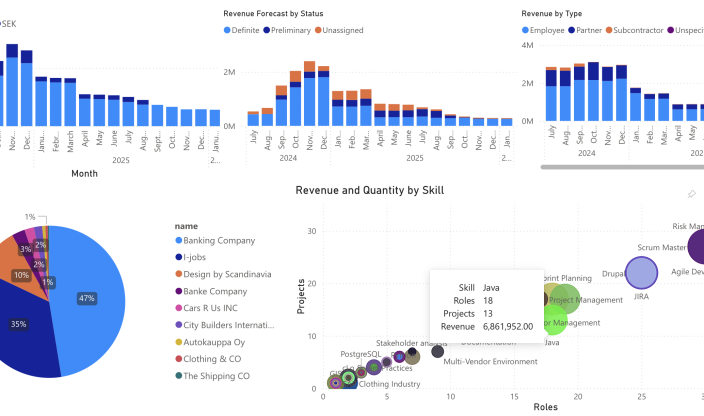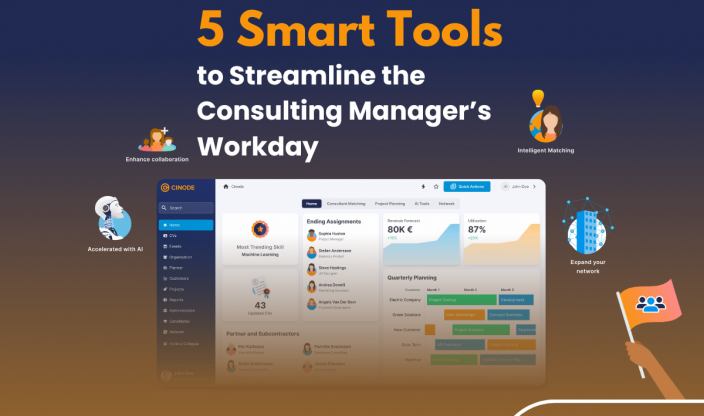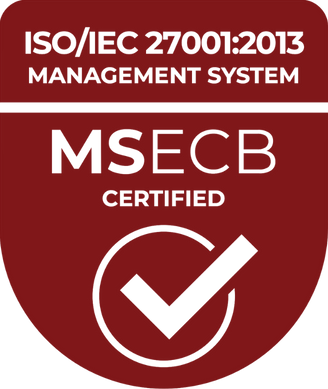How a consulting firm can become a cloud service

Am I the only one who dreams about being able to offer consultancy services as a SaaS company?
- Delivering anywhere at any time, to any number of clients, without needing to think about price pressure or hourly rates.
- Bringing in clients as subscribers. The clients are onboarded and are billed on an ongoing basis, completely automatically based on how they use the services.
- Focusing on developing better services instead of repeating the same work tasks and selling projects on a per-hour basis.
Is this a utopia? Is it possible to develop a consulting firm into a digital delivery machine characterised by scalability and on-demand services?
I believe it is at least possible to get a lot closer to the above situation than where we are at present. By challenging existing models and work methods, we can reach our clients in new ways. Digitalisation facilitates more methods of delivery, and when we develop our deliveries and utilise the technology available, we can update our business models.
Consulting firms are generally fat and happy and are not particularly inclined to update their delivery model or business model. Selling on a per-hour basis is a proven consultancy concept that works, at least for now. The risk, however, is that new concepts, for example readily available and highly competent project resources who work at distance and at a lower price via gig platforms, will begin taking a larger slice of the cake.
When clients realize that they can access awesome resources at a lower price from these gig-platforms, it is likely that certain consulting firms will find it increasingly difficult to compete.
What is SaaS?
SaaS stands for Software as a Service, and really only refers to companies that sell software. There are, however, many other services that use the same model, in other words delivering a service over the internet (the cloud).
Think about all the apps and services you use on a daily basis for work and in private life. You share documents, manage project plans, pay for train tickets, swish a friend, watch something on Netflix, bill a client, etc.
As consultants who offer and provide our services to other companies (B2B), we focus on these types of SaaS offers. Office 365, Salesforce, Googles G Suite, Hubspot, Workday, Mailchimp and Cinode are all examples of SaaS companies from which we draw inspiration.
Updating the sales process – with online funnels and automation
At present within the consulting sector, most client acquisition takes place through traditional sales processes. Senior consultants use their contact network and offer the firm’s services as a solution to the prospective client’s problem. When the client changes direction, the consulting firm is able to follow suit.
If we were a SaaS company instead, we would work more with the client’s buyer journey and identify potential new clients during their own online research prior to purchase.
As a SaaS company, we would help them to understand the problem at a more in-depth level, by offering downloadable guides, webinars and microtools. Thereafter, when our marketing automation system indicates that they have read about our solutions and have visited our pricing page three times during the past week, we send them an email and book a meeting (or perhaps we are still a little old school and call them instead!). The client is then delighted to hear that we can help them with their problem, not to mention surprised at how well we already understand them.
The more advanced cloud consulting companies don’t even need to send an email or make a call. They have functions on their site which allow the client to test/purchase the service straight away. It could be an online training module, a digital assessment tool or an executive coaching session online.
The consulting firm works in this manner in order to gain a more in-depth understanding of the client, which then enables additional relevant services to be offered, either digitally or during a meeting.
It is bound to be easier to book a meeting with a new client if the client has already taken part in a valuable training session online. In certain cases, we do actually need to get together face-to-face and talk about the sizeable projects. This also makes the process more pleasant and personal. Not everything should be handled digitally – but a lot could.
Delivery and value proposition in the cloud?
These days, consulting firms offer and provide competence, time and human resources. Some of the reasons clients choose to engage our services include the fact that we:
- have expertise within a certain field
- can spread knowledge
- act independently/objectively
- can implement change in project form, outside of the line organisation
By streamlining and digitalizing projects and the delivery process, consulting firms can emulate cloud services to a greater extent. In many cases the consulting firm’s specialized expertise can be integrated with a digital solution so that at least certain parts are not delivered by the hour. Some areas to begin with include:
- Repetition – in many projects there are elements of repetition for the consultants. It could, for example, have to do with client training. In large projects, many people are affected, and the project teams provide information and training to organizations to ensure that they will be able to adapt the change in the best possible manner. It is not particularly efficient to hold the same workshop ten times when it could be arranged just once at larger scale. There is also a risk that the quality of the delivery will vary from occasion to occasion due to human factors.
- Communication – meetings and workshops can be enjoyable and can create an enhanced rapport and team feeling, although there are other occasions that are better suited to achieving such goals. When it comes to change projects, it is important to collaborate and communicate clearly. This is often done in the form of countless meetings, and information is shared via available channels (email, intranet, etc.), which means that the projects obtain only limited input. It becomes unclear who has received what info, and who has actually taken the information on board as intended. The lack of traceability makes it difficult (if not impossible) to monitor and follow up, provide support where needed or know whether the organization is ready for the next step in the project.
- Inclusion – all people are different. Certain individuals are particularly good at communicating their own ideas and making their opinions heard. Sometimes this can mean that other people’s ideas take a backseat during workshops and meetings. We know that, generally, the results will be better when consideration is given to more ideas, more input and many perspectives. Now we also have the digital tools to ensure that everyone’s voice can be heard (read more).
- Effect/quality – many failed projects do not fall short due to poor delivery, but rather the fact that the receiving organization was not ready for the change. People must be informed and engaged in order to be willing to implement and accept the change. This is often the reason for projects being delayed.
- Travel – why fly or drive to all sorts of locations, when the meetings can often be held digitally? Even workshops are held in a hybrid environment to a larger extent (some people attend digitally). Just do it right and it becomes a win-win.
Ask yourself these questions: What areas, processes and methods are you mastering as a consultant, but your clients are not? Is it possible to create a service around that, and allow your clients to access that capability digitally? Could it be transfer of skills and knowledge online, or methods built into digital tools, remote coaching sessions or a paywalled expert community? Start small and test something, see if it sticks!
A consulting firm with APIs as a SaaS company?
A significant strength of today’s cloud services is the integration possibilities they provide. Different services can be connected together to utilize shared data and functions through APIs (Application Programming Interface).
- A consulting firm should be able to connect to other platforms that also work with client projects, for example gig-platforms. By synching available consultants with the assignments that turn up on the gig and freelance platforms, the consultants can quickly be assigned to relevant projects. This benefits the consulting firms, the platforms and the clients themselves.
- Furthermore, consulting firms would be able to broaden their field of operation and take a greater overall responsibility in existing client projects by bringing in subcontractor experts via the platforms.
New payment models
Imagine transitioning from hourly reporting to subscriptions with automatic billing and card payments – my favorite area!
For a long time now, the consultancy sector has charged by the hour, which feels about as exciting as a landline phone!
By digitalizing your offers and delivering online, it is also possible to charge your clients in other ways, for example per user and month. 100 SEK (about 10 Euro) per user and month might not sound a lot, but if you have major clients with thousands of employees it can quickly add up.
The nice thing about scalability is that you can benefit from re-use of your service and can continually add new clients. As long as your service delivers value, your clients will keep using it. After a while you might have ten clients with an average of 1,500 users.
Let us consider a simple equation: (1,500 users * 10 clients * 100 SEK * 12 months) = 18 million SEK per year. How much do you normally bill as a consultant per year? =)
In the online world, card payments rule, and there is a reason for that. With a cloud service you can usually test out the solution by registering your details and your credit card within just a few minutes. Naturally, the chances of becoming a long-term client are increased if it is possible to test out the solution straight away.
This also opens the possibility of bypassing some of the bureaucratic procurement processes. If you sell an online training module within your field to many people, they will then report their participation, which contributes to your brand awareness and increases the likelihood of landing larger deals in the long term.
Challenging old work methods
SaaS companies are an awesome source of inspiration, and even if consulting firms might not be able to directly replicate all of the models they use, there are definitely parts that are worth experimenting with.
I am involved in both external client assignments and internal initiatives where we successfully challenge old work methods and business models. One example is something that we at Centigo call Skills (skills.centigo.se). Skills acts as an umbrella under which we gather several digital initiatives for aspects such as the transfer of skills and knowledge, digitalizing workshop facilitation and more efficient work methods in client projects. It has also paved the way for new business models, new partnerships and new career paths. For you as a consultant, I would highly recommend that you take a closer look at the way we conduct workshops more digitally (read more HERE). It is a quick way of digitalizing some of your operations already today.

Guest blogger – Johan Wallquist, management consultant at Centigo
Guest blogger – Johan Wallquist, management consultant at Centigo
You may also like...
All posts
Oct 10 2025 · Consulting, Entrepreneurship
🚀 The Head of Analysis: Seven Success Factors for Consulting Firms 2025–2030

Sep 10 2025 · Consulting
“It’s About Growing Right – Not Fastest” – Netlight Scales Up with Culture and AI in Focus

Aug 21 2025 · Cinode, Consulting
🚀 A Clear View and Fast Execution – Our Journey with Cinode

Apr 30 2025 · Consulting
Understanding the psychology behind pricing

Apr 15 2025 · Consulting
How to set (the right) price?

Mar 18 2025 · Consulting
How do we charge for the value of our services?

Mar 11 2025 · Consulting
New AI Act: Checklist for Consultants and Consulting Firms

Feb 27 2025 · Consulting
Maximize Insights in Your Consulting Business with Cinode and Power BI

Jan 31 2025 · Consulting
5 Smart Tools to Streamline the Consulting Manager’s Workday

Jan 29 2025 · Consulting
New guide: How to Build Consultant Resumes That Win Clients

Nov 05 2024 · Consulting
Sweden’s most profitable consulting company reveals its secrets

Oct 30 2024 · Consulting
